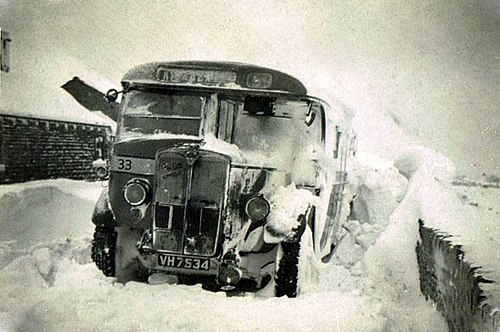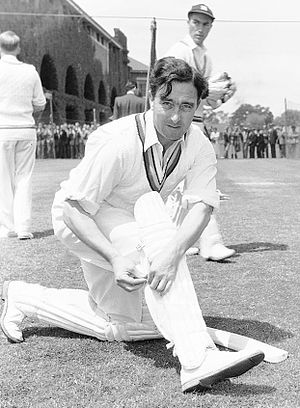1947 cricket season in England and Wales
In Great Britain, the winter of 1946–47 remains one of the coldest and harshest ever recorded. Heavy snowfalls disrupted communication and supply for about six weeks from January to March. February was one of the coldest months on record and March was the wettest for over 300 years. Even so, as recorded by Wisden Cricketers' Almanack in its 85th edition (published in April 1948), the country basked in a glorious summer as fine weather prevailed and "the sun shone throughout".[1] This was in sharp contrast to the wet summer of 1946. This was in sharp contrast to the wet summer of 1946. Despite austerity and rationing, the country was still in post-war euphoria and there was great enthusiasm for sporting events with large crowds at all grounds. In the first-ever edition of Playfair (published in April 1948), editor Peter West wrote that "a grand and glorious summer had been a feast amidst austerity indeed, a fine reward for months of waiting through a chill and infamous winter". West went on to claim that "nearly three million people", with the younger generation strongly represented, attended first-class matches in 1947 (it must be remembered that this means three million attendances and not literally three million people).[2]
The outstanding players of the season were the Middlesex and England batsmen Denis Compton, Bill Edrich and Jack Robertson. Their form was key to Middlesex winning the 48th edition of the official County Championship, their first title since 1921. They were involved in a tight season-long contest with eventual runners-up Gloucestershire, for whom Tom Goddard was the most outstanding bowler of the season. Compton established seasonal batting records that, with the reduction in the number of first-class matches since 1968, will probably never be broken. His totals of 3,816 runs and eighteen centuries are both records for a single season. Edrich scored 3,539 runs (the second-highest ever) with twelve centuries and Robertson scored 2,760 runs with twelve centuries. Goddard took 238 wickets, well clear of next best Doug Wright (Kent; 177) and Peter Smith (Essex; 172). Godfrey Evans (Kent) was the top wicket-keeper with 93 dismissals (68 caught; 25 stumped).
Captained by Alan Melville, South Africa toured the British Isles for the first time since 1935 and played a five-match Test series against England which was won 3–0 by the hosts with two matches drawn. The South Africans enjoyed greater success in first-class matches against the English county teams, losing only one and winning eleven. Melville and his team mate Dudley Nourse had outstanding seasons and were named among the five Wisden Cricketers of the Year. The other three were Robertson, Norman Yardley of Yorkshire and the New Zealander Martin Donnelly of Oxford University.
Other notable fixtures included Gentlemen v Players (twice), North v South (three matches), and the University Match. The Minor Counties Championship was won by Yorkshire II, one of six first-class clubs who entered their second elevens in the competition. Unusually, there were two tied matches in 1947, compared with two in the previous 21 years. Essex v Northamptonshire and Hampshire v Lancashire were the 20th and 21st tied matches in the history of first-class cricket worldwide since the earliest known instance in 1783.
Honours
Test Series. England 3–0 South Africa; two matches drawn
County Championship. Middlesex
Minor Counties Championship. Yorkshire II
Wisden Cricketers of the Year. Martin Donnelly, Alan Melville, Dudley Nourse, Jack Robertson, Norman Yardley
South African tour
South Africa toured the British Isles in 1947 and played a five-match Test series against England, who won the series 3–0 with two matches drawn. This was the first South African tour of England since 1935, the team captained by Alan Melville who had played in England for Oxford University and Sussex. Wisden commented that despite their lack of success in the Test series, South Africa "gave indication of real ability at all points of the game" and "little more experience is necessary to make them really powerful" in international cricket.(CITE) Playfair acclaimed the South Africans as a "most popular team (who) enriched the game and set an excellent example", the tour realising a profit of £10,000.(CITE)
South Africa fared very well in their matches against the county clubs, winning eleven of the eighteen matches and losing only one, which was the opening match of the tour against Worcestershire by 39 runs. They lost to Marylebone Cricket Club (MCC) in May by 158 runs, but in September they had a convincing nine wicket win against the South who included Denis Compton, Bill Edrich and Jack Robertson.
The outstanding South African players were the three best batsmen: Melville, Bruce Mitchell and Dudley Nourse. Ken Viljoen had a good tour and made six centuries but none in the Tests. The bowling was moderate as no one took more than 15 wickets in the series or averaged under forty. Athol Rowan with 102 was the only tourist to take a century of wickets in the season. The team badly lacked pace bowlers and included only two medium-fast seamers, Jack Plimsoll and Lindsay Tuckett, the majority of bowlers being spinners: Rowan, Tufty Mann, Ian Smith and Leslie Payn. South Africa had three wicket-keepers in the party: Johnny Lindsay, Douglas Ovenstone and George Fullerton. Ossie Dawson was an all-rounder and the remaining batsmen were Denis Begbie, Dennis Dyer and Tony Harris. South Africa used fourteen players in the Test series: the ones who missed out were Begbie, Ovenstone and Payn.
Test series summary
- Trent Bridge – match drawn
- Lord's – England won by 10 wickets
- Old Trafford – England won by 7 wickets
- Headingley – England won by 10 wickets
- The Oval – match drawn
England's key victory came in the second Test at Lord's where Compton (208) and Edrich (189) shared a partnership of 370 which was a then world record for the third wicket in Test cricket. Doug Wright took ten wickets in the match and England won by ten wickets. In the third Test at Old Trafford, Edrich scored 191 in another big partnership with Compton and took eight wickets in the match. England won the fourth Test at Headingley in only three days by ten wickets. This time it was Len Hutton and Cyril Washbrook who claimed the batting honours while the best bowler was Harold Butler with match figures of seven for 66 on debut.
Notes
- ↑ Preston, Hubert (editor) (1948). A Wonderful Season. John Wisden & Co. Ltd.
- ↑ Playfair, page 8.
Bibliography
- Birley, Derek: A Social History of English Cricket. Aurum (1999).
- Bowen, Rowland: Cricket: A History of its Growth and Development. Eyre & Spottiswoode (1970).
- Playfair: Playfair Cricket Annual 1948. First edition, edited by Peter West. Playfair Books (1948).
- Preston, Hubert (editor): Wisden Cricketers' Almanack – 84th Edition. Sporting Handbooks Ltd (1947).
- Preston, Hubert (editor): Wisden Cricketers' Almanack – 85th Edition. Sporting Handbooks Ltd (1948).
- Swanton, E. W. (editor): Barclays World of Cricket, 3rd edition. Willow Books (1986).
- Webber, Roy: The County Cricket Championship. Sportsman's Book Club (1958).
- Webber, Roy: The Phoenix History of Cricket. Phoenix (1960).
- Webber, Roy: The Playfair Book of Cricket Records. Playfair Books (1951).


